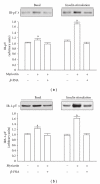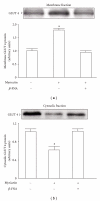Myricetin Ameliorates Defective Post-Receptor Insulin Signaling via β-Endorphin Signaling in the Skeletal Muscles of Fructose-Fed Rats
- PMID: 21785619
- PMCID: PMC3136182
- DOI: 10.1093/ecam/neq017
Myricetin Ameliorates Defective Post-Receptor Insulin Signaling via β-Endorphin Signaling in the Skeletal Muscles of Fructose-Fed Rats
Abstract
β-Endorphin plays a major role in the amelioration of insulin resistance. The present study documents that myricetin (3,5,7,3', 4', 5'-hexahydroxyflavone) ameliorates insulin resistance by enhancing β-endorphin production in insulin-resistant rats. The rats were induced for insulin resistance by feeding them a diet containing 60% fructose for 6 weeks. The degree of insulin resistance was measured by the homeostasis model assessment of basal insulin resistance (HOMA-IR). The plasma levels of insulin and β-endorphin were measured by an enzyme-linked immunosorbent assay. The insulin receptor-related signaling mediators in the soleus muscles of rats were evaluated by immunoprecipitation or immunoblotting. Myricetin was injected daily (1 mg kg(-1) per injection, thrice daily) for 14 days. Consequently, the high-glucose plasma levels in fructose-fed rats decreased significantly concomitant with an increase in plasma β-endorphin. The reduction of the elevated HOMA-IR index following treatment with myricetin was subsequently inhibited by the administration of β-funaltrexamine hydrochloride (β-FNA) at doses sufficient to block μ-opioid receptors (MOR). The myricetin treatment was also observed to affect the phosphorylation of the insulin receptor, insulin receptor substrate-1, Akt and Akt substrate of 160 kDa, with subsequent effects on glucose-transporter subtype 4 translocation, all of which were blocked by β-FNA pretreatment. These results indicated that enhancement of β-endorphin secretion, which in turn leads to peripheral MOR activation, is involved in the action of myricetin on the amelioration of impaired signaling intermediates downstream of insulin receptors.
Figures






Similar articles
-
Myricetin, a naturally occurring flavonol, ameliorates insulin resistance induced by a high-fructose diet in rats.Life Sci. 2007 Nov 10;81(21-22):1479-88. doi: 10.1016/j.lfs.2007.08.045. Epub 2007 Oct 2. Life Sci. 2007. PMID: 17976658
-
Infusion of beta-endorphin improves insulin resistance in fructose-fed rats.Horm Metab Res. 2004 Aug;36(8):571-7. doi: 10.1055/s-2004-825763. Horm Metab Res. 2004. PMID: 15326568
-
Mediation of beta-endorphin in exercise-induced improvement in insulin resistance in obese Zucker rats.Diabetes Metab Res Rev. 2005 Mar-Apr;21(2):175-82. doi: 10.1002/dmrr.496. Diabetes Metab Res Rev. 2005. PMID: 15386812
-
Opioid μ-receptors as new target for insulin resistance.Pharmacol Ther. 2013 Sep;139(3):334-40. doi: 10.1016/j.pharmthera.2013.05.002. Epub 2013 May 18. Pharmacol Ther. 2013. PMID: 23688574 Review.
-
Mediation of beta-endorphin by myricetin to lower plasma glucose in streptozotocin-induced diabetic rats.J Ethnopharmacol. 2006 Mar 8;104(1-2):199-206. doi: 10.1016/j.jep.2005.09.001. Epub 2005 Oct 3. J Ethnopharmacol. 2006. PMID: 16203117
Cited by
-
Myricetin bioactive effects: moving from preclinical evidence to potential clinical applications.BMC Complement Med Ther. 2020 Aug 1;20(1):241. doi: 10.1186/s12906-020-03033-z. BMC Complement Med Ther. 2020. PMID: 32738903 Free PMC article. Review.
-
Screening and biological evaluation of myricetin as a multiple target inhibitor insulin, epidermal growth factor, and androgen receptor; in silico and in vitro.Invest New Drugs. 2015 Jun;33(3):575-93. doi: 10.1007/s10637-015-0240-8. Epub 2015 Apr 19. Invest New Drugs. 2015. PMID: 25895100
-
Diosgenin and 5-Methoxypsoralen Ameliorate Insulin Resistance through ER-α/PI3K/Akt-Signaling Pathways in HepG2 Cells.Evid Based Complement Alternat Med. 2016;2016:7493694. doi: 10.1155/2016/7493694. Epub 2016 Aug 31. Evid Based Complement Alternat Med. 2016. PMID: 27656241 Free PMC article.
-
The Epigenetic Link between Polyphenols, Aging and Age-Related Diseases.Genes (Basel). 2020 Sep 18;11(9):1094. doi: 10.3390/genes11091094. Genes (Basel). 2020. PMID: 32962067 Free PMC article. Review.
-
Flavonoids in Treatment of Chronic Kidney Disease.Molecules. 2022 Apr 6;27(7):2365. doi: 10.3390/molecules27072365. Molecules. 2022. PMID: 35408760 Free PMC article. Review.
References
-
- Ong KC, Khoo H-E. Biological effects of myricetin. General Pharmacology. 1997;29(2):121–126. - PubMed
-
- Ko C-H, Shen S-C, Lee TJF, Chen Y-C. Myricetin inhibits matrix metalloproteinase 2 protein expression and enzyme activity in colorectal carcinoma cells. Molecular Cancer Therapeutics. 2005;4(2):281–290. - PubMed
-
- Ong KC, Khoo H-E. Insulinomimetic effects of myricetin on lipogenesis and glucose transport in rat adipocytes but not glucose transporter translocation. Biochemical Pharmacology. 1996;51(4):423–429. - PubMed
-
- Ong KC, Khoo H-E. Effects of myricetin on glycemia and glycogen metabolism in diabetic rats. Life Sciences. 2000;67(14):1695–1705. - PubMed
-
- Liu I-M, Liou S-S, Lan T-W, Hsu F-L, Cheng J-T. Myricetin as the active principle of Abelmoschus moschatus to lower plasma glucose in streptozotocin-induced diabetic rats. Planta Medica. 2005;71(7):617–621. - PubMed
LinkOut - more resources
Full Text Sources
Molecular Biology Databases
Research Materials

